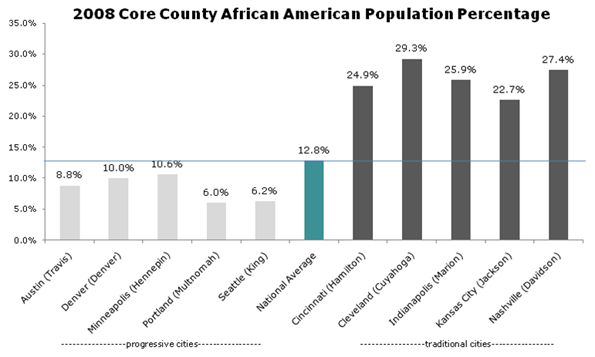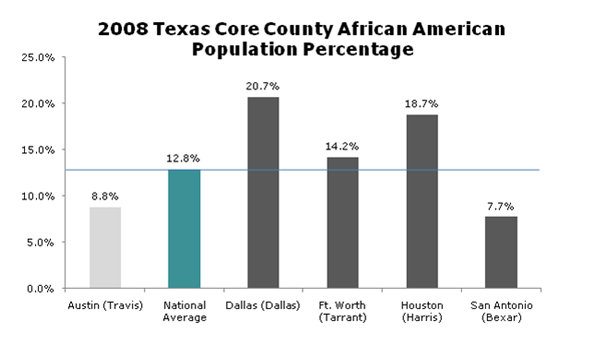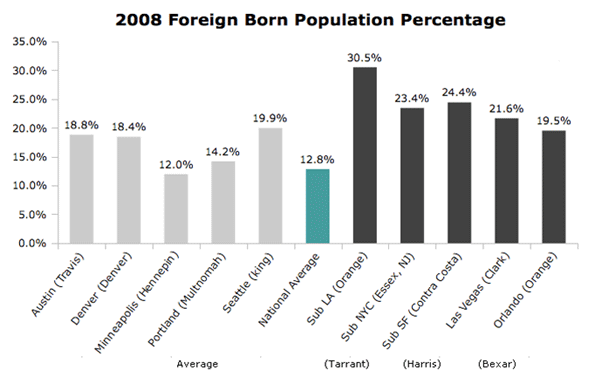
Among the media, academia and within planning circles, there’s a generally standing answer to the question of what cities are the best, the most progressive and best role models for small and mid-sized cities. The standard list includes Portland, Seattle, Austin, Minneapolis, and Denver. In particular, Portland is held up as a paradigm, with its urban growth boundary, extensive transit system, excellent cycling culture, and a pro-density policy. These cities are frequently contrasted with those of the Rust Belt and South, which are found wanting, often even by locals, as “cool” urban places.
But look closely at these exemplars and a curious fact emerges. If you take away the dominant Tier One cities like New York, Chicago and Los Angeles you will find that the “progressive” cities aren’t red or blue, but another color entirely: white.
In fact, not one of these “progressive” cities even reaches the national average for African American percentage population in its core county. Perhaps not progressiveness but whiteness is the defining characteristic of the group.

The progressive paragon of Portland is the whitest on the list, with an African American population less than half the national average. It is America's ultimate White City. The contrast with other, supposedly less advanced cities is stark.
It is not just a regional thing, either. Even look just within the state of Texas, where Austin is held up as a bastion of right thinking urbanism next to sprawlvilles like Dallas-Ft. Worth and Houston.

Again, we see that Austin is far whiter than either Dallas-Ft. Worth or Houston.
This raises troubling questions about these cities. Why is it that progressivism in smaller metros is so often associated with low numbers of African Americans? Can you have a progressive city properly so-called with only a disproportionate handful of African Americans in it? In addition, why has no one called these cities on it?
As the college educated flock to these progressive El Dorados, many factors are cited as reasons: transit systems, density, bike lanes, walkable communities, robust art and cultural scenes. But another way to look at it is simply as White Flight writ large. Why move to the suburbs of your stodgy Midwest city to escape African Americans and get criticized for it when you can move to Portland and actually be praised as progressive, urban and hip? Many of the policies of Portland are not that dissimilar from those of upscale suburbs in their effects. Urban growth boundaries and other mechanisms raise land prices and render housing less affordable exactly the same as large lot zoning and building codes that mandate brick and other expensive materials do. They both contribute to reducing housing affordability for historically disadvantaged communities. Just like the most exclusive suburbs.
This lack of racial diversity helps explain why urban boosters focus increasingly on international immigration as a diversity measure. Minneapolis, Portland and Austin do have more foreign born than African Americans, and do better than Rust Belt cities on that metric, but that's a low hurdle to jump. They lack the diversity of a Miami, Houston, Los Angeles or a host of other unheralded towns from the Texas border to Las Vegas and Orlando. They even have far fewer foreign born residents than many suburban counties of America's major cities.

The relative lack of diversity in places like Portland raises some tough questions the perennially PC urban boosters might not want to answer. For example, how can a city define itself as diverse or progressive while lacking in African Americans, the traditional sine qua non of diversity, and often in immigrants as well?
Imagine a large corporation with a workforce whose African American percentage far lagged its industry peers, sans any apparent concern, and without a credible action plan to remediate it. Would such a corporation be viewed as a progressive firm and employer? The answer is obvious. Yet the same situation in major cities yields a different answer. Curious.
In fact, lack of ethnic diversity may have much to do with what allows these places to be “progressive”. It's easy to have Scandinavian policies if you have Scandinavian demographics. Minneapolis-St. Paul, of course, is notable in its Scandinavian heritage; Seattle and Portland received much of their initial migrants from the northern tier of America, which has always been heavily Germanic and Scandinavian.
In comparison to the great cities of the Rust Belt, the Northeast, California and Texas, these cities have relatively homogenous populations. Lack of diversity in culture makes it far easier to implement “progressive” policies that cater to populations with similar values; much the same can be seen in such celebrated urban model cultures in the Netherlands and Scandinavia. Their relative wealth also leads to a natural adoption of the default strategy of the upscale suburb: the nicest stuff for the people with the most money. It is much more difficult when you have more racially and economically diverse populations with different needs, interests, and desires to reconcile.
In contrast, the starker part of racial history in America has been one of the defining elements of the history of the cities of the Northeast, Midwest, and South. Slavery and Jim Crow led to the Great Migration to the industrial North, which broke the old ethnic machine urban consensus there. Civil rights struggles, fair housing, affirmative action, school integration and busing, riots, red lining, block busting, public housing, the emergence of black political leaders – especially mayors – prompted white flight and the associated disinvestment, leading to the decline of urban schools and neighborhoods.
There's a long, depressing history here.
In Texas, California, and south Florida a somewhat similar, if less stark, pattern has occurred with largely Latino immigration. This can be seen in the evolution of Miami, Los Angeles, and increasingly Houston, San Antonio and Dallas. Just like African-Americans, Latino immigrants also are disproportionately poor and often have different site priorities and sensibilities than upscale whites.
This may explain why most of the smaller cities of the Midwest and South have not proven amenable to replicating the policies of Portland. Most Midwest advocates of, for example, rail transit, have tried to simply transplant the Portland solution to their city without thinking about the local context in terms of system goals and design, and how to sell it. Civic leaders in city after city duly make their pilgrimage to Denver or Portland to check out shiny new transit systems, but the resulting videos of smiling yuppies and happy hipsters are not likely to impress anyone over at the local NAACP or in the barrios.
We are seeing this script played out in Cincinnati presently, where an odd coalition of African Americans and anti-tax Republicans has formed to try to stop a streetcar system. Streetcar advocates imported Portland's solution and arguments to Cincinnati without thinking hard enough to make the case for how it would benefit the whole community.
That's not to let these other cities off the hook. Most of them have let their urban cores decay. Almost without exception, they have done nothing to engage with their African American populations. If people really believe what they say about diversity being a source of strength, why not act like it? I believe that cities that start taking their African American and other minority communities seriously, seeing them as a pillar of civic growth, will reap big dividends and distinguish themselves in the marketplace.
This trail has been blazed not by the “progressive” paragons but by places like Atlanta, Dallas and Houston. Atlanta, long known as one of America's premier African American cities, has boomed to become the capital of the New South. It should come as no surprise that good for African Americans has meant good for whites too. Similarly, Houston took in tens of thousands of mostly poor and overwhelmingly African American refugees from Hurricane Katrina. Houston, a booming metro and emerging world city, rolled out the welcome mat for them – and for Latinos, Asians and other newcomers. They see these people as possessing talent worth having.
This history and resulting political dynamic could not be more different from what happened in Portland and its “progressive” brethren. These cities have never been black, and may never be predominately Latino. Perhaps they cannot be blamed for this but they certainly should not be self-congratulatory about it or feel superior about the urban policies a lack of diversity has enabled.
Aaron M. Renn is an independent writer on urban affairs based in the Midwest. His writings appear at The Urbanophile.













"African Americans are
"African Americans are notoriously intolerant of other minorities."
Hmmmm, Yeaaah, Um...I'm gonna have to go ahead and...disagree with you there...
Actually, this statement is plain wrong. Blacks are very welcoming to other minorities. I'm not sure if you are calling 'homosexuals' a 'minority'. I am black, and grew up in the inner city, went to college, and live around midclass Americans (point being, I have been around all kinds of african americans--ghetto to snobbish).
I have never (that I can recall) heard a black express dissatisfaction of the growing hispanic or asian population. So, I am not sure where you are getting this from--comedians maybe. Oh, to be fair, some do complain about Asians owning liquor stores, beauty supplies, and swapmeets, and some complain about Indians, but thats about the extent of it. We typically get along with other minorities as long as they are not rude to us, from my experience. (I am making this point becuase this seems to be a common misconception about black people. I have no idea where this comes from.) If I am wrong, I stand corrected...but I would need to see something that proves this statement.
Now the previous post was correct about intolerance of gay marriage. This has more validity. If you are calling gays a monority then this may be a good point.
gays
Yep, gays are definately a minority, with their own unique contributions to the vibe of a city.
Your Argument Has a Fatally Flawed Premise
"For example, how can a city define itself as diverse or progressive while lacking in African Americans, the traditional sine qua non of diversity, and often in immigrants as well?"
I'm sorry but this is just a nonsense. Diverse, if it means anything, means reflecting the background of society. It is no crime against diversity or progressivism to have a Black population that is at or near their national share of population--particularly when, as in the case of Austin, any deficit is more than made up with Hispanics and Asians at levels above the national average!
This is ignoring a lot of history
I don't know any of the white cities you list but I do know Indianapolis and Detroit. I don't believe any of those white cities ever had a substantial African American population and were therefore never subjected to the racial tensions, violence and crime that cities like Indianapolis and Detroit had. The rings of suburbs around Detroit and Indianapolis didn't appear simply because of white racism alone. Urban decay was not the result of white racism alone. The steep decrease of property values in these cities was not due to white racism alone.
Portland, Austin and the other white cities never experienced that tension, their downtown's never suffered that decay so property values in the cities never collapsed like they did in Indy and Detroit so they were able to invest in the kind of infrastructure to appeal to progressive, educated folks.
It's facile to blame white racism on every discrepancy between whites and blacks but it doens't make it accurate.
Less than 50% of Austin's
Less than 50% of Austin's population is "White". I guess in the author's mind less black equals more white?
City of Austin
Median age - 31.7
White - 49.2% (382,649)
Hispanic - 35.4% (275,637)
Black - 7.8% (60,841)
Asian - 5.5% (42,933)
Two or more races - 1.5% (11,413)
Foreign born - 20.0% (155,923)
Travis County
Median age - 32.5
White - 51.5% (514,703)
Hispanic - 32.9% (328,217)
Black - 8.1% (81,276)
Asian - 5.3% (53,229)
Two or more races - 1.6% (15,729)
Foreign born - 18.3% (182,743)
Austin-Round Rock MSA
Median age - 32.6
White - 56.3% (930,035)
Hispanic - 30.2% (498,182)
Black - 7.2% (118,300)
Asian - 4.4% (72,165)
Two or more races - 1.4% (23,614)
Foreign born - 14.5% (239,509)
This data is from the 2008 U.S. Census Bureau estimates.
I'm a teacher
and we spend a lot of (wasted*) time talking about the achievement gap between whites and students of color. Our Asian population, which is larger than our African American population, is considered white for the purposes of these exercises since they are as successful or more successful in average than the white population. That pisses of our Asian teachers to no end.
wasted* - I say wasted as no improvement has come from these exercises, not even a suggestion for improvement.
African American does not EQUAL Minority!
Being an African American who lived in Austin over 20 years, I am fully aware of amazing diversity that the city offers....minus the Black population. Theses cities do provide diversity through various cultural groups and the Latino population. I think that we must be very careful to equate the word "minority" with African American as that can emcompass many groups. My personal choice was to leave Austin to live in Baltimore, a city with a 65% Black population, which I find not to be nearly as diverse as you may think. There are small sprinkles of Italians and Jews but rarely do you see the groups interacting together nor beyond experiencing African American culture do I get a glimpse of additional cultural outlets. I miss the dynamics that Austin presented....but my give and take is the tremendous opportunity to learn more about my African American culture through living in this city.
Presence does not Equal Diversity
Mr. Renn, this is a thought-provoking post about a very important topic. Unfortunately, like other commenters, I must take issue with your conclusions based on your data. I have written a response to the main points on my blog. Basically, I find two problems: first, only looking at percentage African American misses a huge amount of diversity in the population and second, the mere presence of African Americans does not mean that they are integrated. In fact, many of the metropolitan areas that you hold up in comparison are much more segregated than the "model progressive" cities you discuss here.
As a side note, in response to one of your comments above, I used central-city numbers to look at racial composition and find very different results than you do using central county figures. I maintain that counties are not any more systematically similar than corporate limits of cities and, given that your interest is in policies, most of those are enacted at the city -- not county -- level (with notable exceptions like Indianapolis and Louisville).
what about other minorities?
What about Asians? I know for s fact that Seattle has an Asian population of about 15%. Minneapolis, Portland and Austin also have higher than average percentages of Asians.
PS I have never known Denver to be a particularly progressive city.
PPS What about San Francisco?!?! San Francisco is only 45% white. It is 33% Asian and 15% Latino.
Is this a Surprise
"This history and resulting political dynamic could not be more different from what happened in Portland and its “progressive” brethren.
These cities have never been black, and may never be predominately Latino. Perhaps they cannot be blamed for this but they certainly should not be self-congratulatory about it or feel superior about the urban policies a lack of diversity has enabled.?"
Why not? I could not disagree with you more on your under challenged, fully expected, half backed mushy liberal stance.
If these progressive cities have a formula for success, and that formula is that a larger proportion of the population can collaborate with one another to reach more consensus based solutions than even that should be celebrated. My point isn’t that they are more of the same national heritage and ancestry.
I am making the point that in these cities there is a higher than normal level of social contract and conscientiousness. If that is in fact the case then we should celebrate that. I live in NYC. It is a mess of conflict and rudeness. People literally will walk right into you to prove to you that they aren’t budging for anyone. I don’t care if you are African or Danish American, what is wrong with a little social courtesy?
Is it because NYC is so multicultural that it is a quagmire? Yes but that’s a smaller point than that of our nation having no idea how to manage multi cultural populations. How do we set expectations of one another as residents and hold each other accountable for acting in a way that fosters social harmony. Maybe we are too scared to be branded with the scarlet letter of today…the big R for Racist for expecting African American to defer the right of way from time to time when walking on the sidewalk as it were. Or to not drop their McDonalds bags on the street when they decide they are done with their meal and we pass by silently knowing there is no consequence and no feedback given.
We are too scared of being labeled to create a new more racially inclusive version of a collaborative community that lives by a consensus based social contract. This Fear of being branded Racist will continue to diminish quality of life in multi-cultural cities and will force us to continue hitting the glass ceiling of race relations progress.
Let us not celebrate NYC because it has a high percent of minorities and blast Portland because the city is great and it works. That is backward logic and it makes no sense unless you are blind to the facts and fully brainwashed.